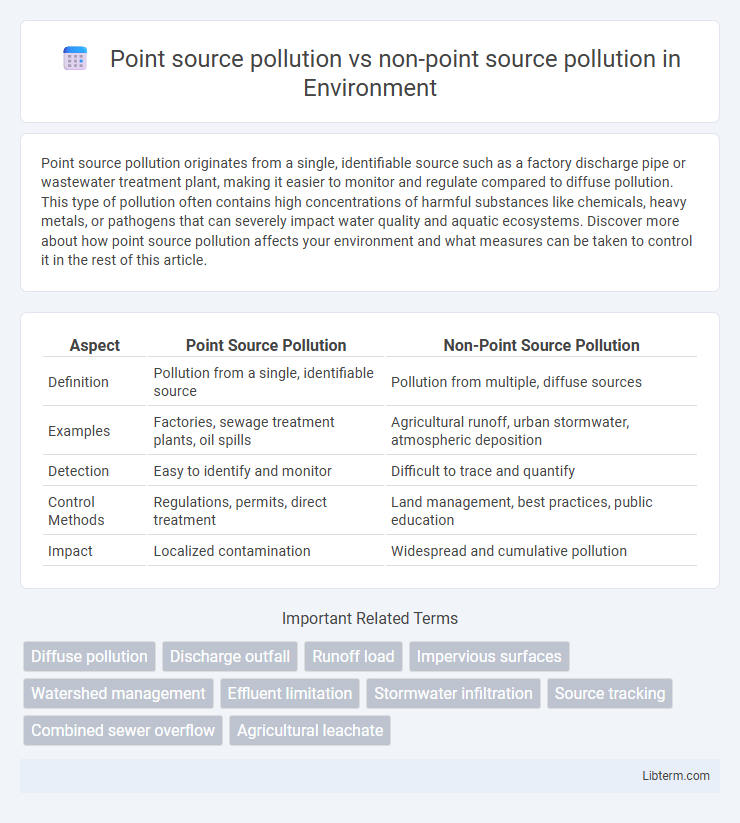Point source pollution originates from a single, identifiable source such as a factory discharge pipe or wastewater treatment plant, making it easier to monitor and regulate compared to diffuse pollution. This type of pollution often contains high concentrations of harmful substances like chemicals, heavy metals, or pathogens that can severely impact water quality and aquatic ecosystems. Discover more about how point source pollution affects your environment and what measures can be taken to control it in the rest of this article.
Table of Comparison
| Aspect | Point Source Pollution | Non-Point Source Pollution |
|---|---|---|
| Definition | Pollution from a single, identifiable source | Pollution from multiple, diffuse sources |
| Examples | Factories, sewage treatment plants, oil spills | Agricultural runoff, urban stormwater, atmospheric deposition |
| Detection | Easy to identify and monitor | Difficult to trace and quantify |
| Control Methods | Regulations, permits, direct treatment | Land management, best practices, public education |
| Impact | Localized contamination | Widespread and cumulative pollution |
Introduction to Water Pollution Sources
Point source pollution originates from identifiable locations such as factories, wastewater treatment plants, or oil spills, allowing for easier monitoring and regulation. Non-point source pollution comes from diffuse sources like agricultural runoff, urban stormwater, and atmospheric deposition, which makes it challenging to control due to its scattered nature. Understanding these distinctions is crucial for developing targeted water management strategies and reducing contaminant loads in aquatic ecosystems.
Defining Point Source Pollution
Point source pollution originates from a single, identifiable source, such as a factory discharge pipe or sewage treatment plant outlet, making it easier to monitor and regulate. This type of pollution releases contaminants directly into water bodies, often involving pollutants like chemicals, heavy metals, or pathogens. Effective management relies on permits and control technologies to limit pollutant emissions at these specific points.
Understanding Non-Point Source Pollution
Non-point source pollution originates from diffuse sources such as agricultural runoff, urban stormwater, and atmospheric deposition, making it challenging to monitor and control compared to point source pollution, which comes from identifiable locations like factories or sewage treatment plants. This type of pollution carries nutrients, pesticides, sediments, and pathogens into water bodies, contributing significantly to water quality degradation and ecosystem damage. Effective management requires comprehensive land-use planning, best management practices (BMPs), and public education to reduce pollutant loads entering aquatic environments.
Key Differences Between Point and Non-Point Source Pollution
Point source pollution originates from a single, identifiable source such as a factory discharge pipe, whereas non-point source pollution comes from diffuse sources like agricultural runoff or urban stormwater. Point source pollution is easier to monitor and regulate due to its specific origin, while non-point source pollution presents challenges because it involves multiple, scattered sources across a wide area. Effective management strategies differ, with point source pollution relying on permits and direct controls, and non-point source pollution requiring best management practices and watershed-scale approaches.
Common Examples of Point Source Pollution
Point source pollution originates from identifiable, discrete sources such as factories discharging wastewater, sewage treatment plants releasing effluents, and oil refineries emitting pollutants through pipes or channels. Industrial facilities often contribute heavy metals and toxic chemicals directly into water bodies, while wastewater treatment plants can release contaminants like nutrients and pathogens. These concentrated discharge points allow for easier regulation and monitoring compared to non-point source pollution, which is diffuse and comes from multiple, scattered sources.
Typical Sources of Non-Point Source Pollution
Typical sources of non-point source pollution include agricultural runoff, urban stormwater, and sediment from construction sites, which carry nutrients, pesticides, and debris into water bodies. Unlike point source pollution, which originates from identifiable discharge points like sewage treatment plants or factories, non-point source pollution is diffuse and challenging to control. This pollution significantly contributes to water quality degradation, causing issues such as algal blooms and habitat disruption in lakes, rivers, and coastal waters.
Environmental Impacts of Point Source Pollution
Point source pollution originates from identifiable, discrete sources such as factories, sewage treatment plants, or oil spills, leading to concentrated release of pollutants directly into water bodies or air. This type of pollution often causes significant environmental damage, including localized eutrophication, toxic contamination of aquatic ecosystems, and harm to wildlife due to elevated concentrations of heavy metals, nutrients, and hazardous chemicals. The clear detectability of these sources allows for targeted mitigation measures, yet their intense pollutant loads can result in rapid degradation of water quality and biodiversity loss in affected areas.
Effects of Non-Point Source Pollution on Ecosystems
Non-point source pollution introduces diffuse contaminants such as agricultural runoff, sediment, and nutrients into ecosystems, leading to eutrophication and harmful algal blooms that degrade water quality and oxygen levels. This pollution disrupts aquatic habitats, reducing biodiversity and altering food webs by contaminating drinking water sources and harming fish populations. Soil erosion and chemical leaching further degrade terrestrial and aquatic environments, undermining ecosystem functions and resilience.
Strategies for Controlling Point Source Pollution
Point source pollution is controlled effectively through strategies such as implementing stringent regulations on industrial discharges, upgrading wastewater treatment plants, and enforcing permits under the Clean Water Act. Installing advanced filtration systems and promoting best management practices in factories reduce contaminants directly entering water bodies from identifiable sources. Continuous monitoring and rapid response to violations ensure compliance and protect aquatic ecosystems from harmful pollutants.
Approaches to Mitigate Non-Point Source Pollution
Mitigating non-point source pollution requires implementing best management practices (BMPs) such as riparian buffer zones, sustainable agricultural techniques, and green infrastructure to reduce runoff and enhance water infiltration. Policies promoting soil conservation, nutrient management plans, and wetland restoration effectively decrease pollutants from diffuse sources like agricultural fields and urban areas. Public education and community-based watershed programs further support the reduction of contaminants entering water bodies from widespread and variable sources.
Point source pollution Infographic

 libterm.com
libterm.com